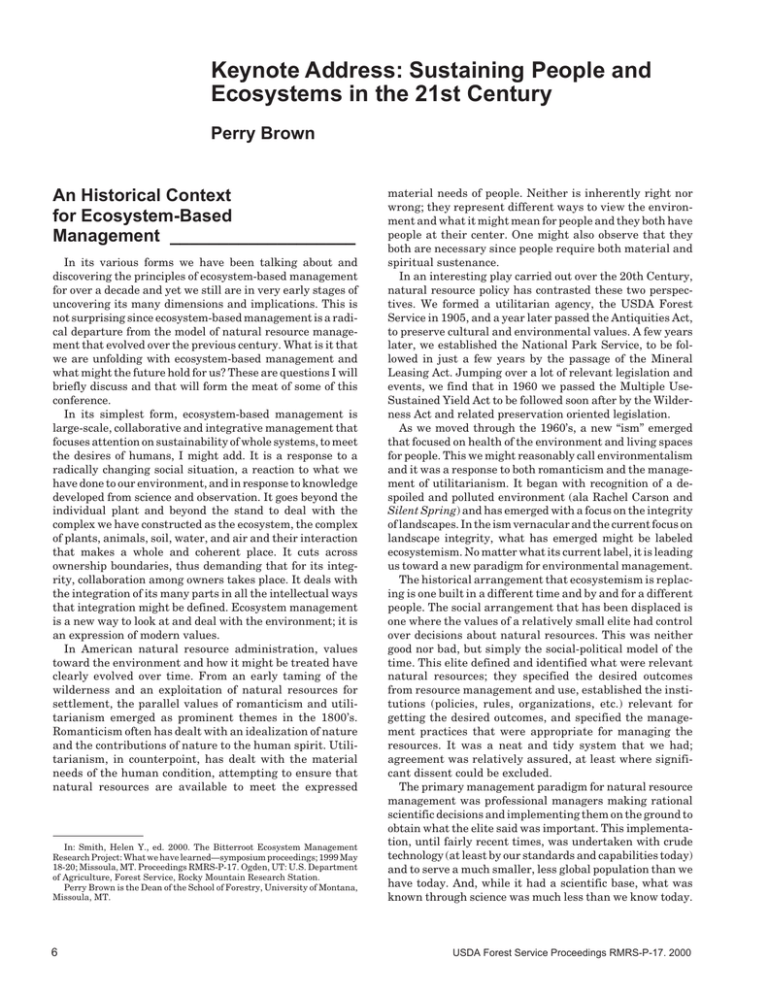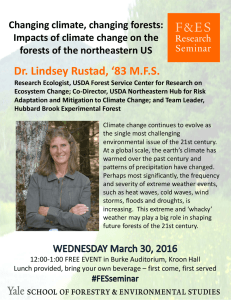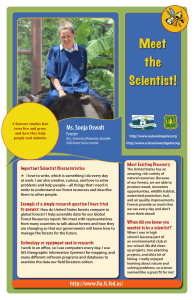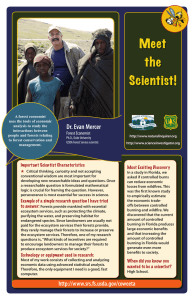Keynote Address: Sustaining People and Ecosystems in the 21st Century Perry Brown
advertisement

Keynote Address: Sustaining People and Ecosystems in the 21st Century Perry Brown An Historical Context for Ecosystem-Based Management ___________________ In its various forms we have been talking about and discovering the principles of ecosystem-based management for over a decade and yet we still are in very early stages of uncovering its many dimensions and implications. This is not surprising since ecosystem-based management is a radical departure from the model of natural resource management that evolved over the previous century. What is it that we are unfolding with ecosystem-based management and what might the future hold for us? These are questions I will briefly discuss and that will form the meat of some of this conference. In its simplest form, ecosystem-based management is large-scale, collaborative and integrative management that focuses attention on sustainability of whole systems, to meet the desires of humans, I might add. It is a response to a radically changing social situation, a reaction to what we have done to our environment, and in response to knowledge developed from science and observation. It goes beyond the individual plant and beyond the stand to deal with the complex we have constructed as the ecosystem, the complex of plants, animals, soil, water, and air and their interaction that makes a whole and coherent place. It cuts across ownership boundaries, thus demanding that for its integrity, collaboration among owners takes place. It deals with the integration of its many parts in all the intellectual ways that integration might be defined. Ecosystem management is a new way to look at and deal with the environment; it is an expression of modern values. In American natural resource administration, values toward the environment and how it might be treated have clearly evolved over time. From an early taming of the wilderness and an exploitation of natural resources for settlement, the parallel values of romanticism and utilitarianism emerged as prominent themes in the 1800’s. Romanticism often has dealt with an idealization of nature and the contributions of nature to the human spirit. Utilitarianism, in counterpoint, has dealt with the material needs of the human condition, attempting to ensure that natural resources are available to meet the expressed In: Smith, Helen Y., ed. 2000. The Bitterroot Ecosystem Management Research Project: What we have learned—symposium proceedings; 1999 May 18-20; Missoula, MT. Proceedings RMRS-P-17. Ogden, UT: U.S. Department of Agriculture, Forest Service, Rocky Mountain Research Station. Perry Brown is the Dean of the School of Forestry, University of Montana, Missoula, MT. 6 material needs of people. Neither is inherently right nor wrong; they represent different ways to view the environment and what it might mean for people and they both have people at their center. One might also observe that they both are necessary since people require both material and spiritual sustenance. In an interesting play carried out over the 20th Century, natural resource policy has contrasted these two perspectives. We formed a utilitarian agency, the USDA Forest Service in 1905, and a year later passed the Antiquities Act, to preserve cultural and environmental values. A few years later, we established the National Park Service, to be followed in just a few years by the passage of the Mineral Leasing Act. Jumping over a lot of relevant legislation and events, we find that in 1960 we passed the Multiple UseSustained Yield Act to be followed soon after by the Wilderness Act and related preservation oriented legislation. As we moved through the 1960’s, a new “ism” emerged that focused on health of the environment and living spaces for people. This we might reasonably call environmentalism and it was a response to both romanticism and the management of utilitarianism. It began with recognition of a despoiled and polluted environment (ala Rachel Carson and Silent Spring) and has emerged with a focus on the integrity of landscapes. In the ism vernacular and the current focus on landscape integrity, what has emerged might be labeled ecosystemism. No matter what its current label, it is leading us toward a new paradigm for environmental management. The historical arrangement that ecosystemism is replacing is one built in a different time and by and for a different people. The social arrangement that has been displaced is one where the values of a relatively small elite had control over decisions about natural resources. This was neither good nor bad, but simply the social-political model of the time. This elite defined and identified what were relevant natural resources; they specified the desired outcomes from resource management and use, established the institutions (policies, rules, organizations, etc.) relevant for getting the desired outcomes, and specified the management practices that were appropriate for managing the resources. It was a neat and tidy system that we had; agreement was relatively assured, at least where significant dissent could be excluded. The primary management paradigm for natural resource management was professional managers making rational scientific decisions and implementing them on the ground to obtain what the elite said was important. This implementation, until fairly recent times, was undertaken with crude technology (at least by our standards and capabilities today) and to serve a much smaller, less global population than we have today. And, while it had a scientific base, what was known through science was much less than we know today. USDA Forest Service Proceedings RMRS-P-17. 2000 What Has Happened to Change the Situation? ______________________ We have had an information revolution where access to information is nearly instantaneous, and where both accurate and inaccurate information and images are readily available to nearly all. Just go to the Internet to see and read nearly anything you want and don’t want to see. Or, watch the nightly news on CNN to learn what is happening at the moment nearly anywhere on the globe, and sometimes even beyond the Earth. We are inundated with real time information, and a lot of it. It is there for us to use and abuse, and we seem to do a lot of both. We have enfranchised a plurality of interests who now have been accorded a legitimate interest in natural resource decision-making. Not that small elite that I talked about before, but a lot of people have been enfranchised. As the spirit of inclusiveness has permeated natural resource discussions, the plurality of interests has expanded and decision-making has become far more complex. No longer are the values of the small elite the controlling values regarding environmental management. There are many more voices to which we must attend, and they offer many more ideas for our consideration. Participatory democracy has become the mode in vogue, even at the expense of a sound history of representative democracy. Individuals and groups demand to be at the table making decisions and determining whether or not they will be implemented. This has a populist appeal in its inclusiveness, but it cuts at the heart of professional management and action and sometimes, as we all know, renders expertise mute. We have recognized that many of our environmental problems are large, complex, technical, and very difficult to solve. Dealing with human communities, with migratory and resident wildlife, with forest mosaics, with global pollution and climate change and myriad other phenomena is complex and changes the way we view management roles, responsibilities, and practices. We also have learned a lot more about the environment and a lot more about what we don’t know about the environment. This has led to both conflicting scientific pronouncements and to confusion among politicians and publics, while at the same time leading to a more conservation-oriented approach to environmental management. As we have learned, we have become more conservative in our actions through the fear of doing things to the environment that are irreversible. At times this had led to no action, and at other times this has led to ignoring change that is inevitable. Finally, we have seen what we have done to the environment from ignorance, from the speed and efficiencies of new technologies, and from greed and short sightedness. For example, for decades throughout the 20th Century timber harvesting on public lands was confined to relatively small areas and the visual and ecological disruption of western forests particularly was minimal. In the west, this meant that the carpet of green that was forest was relatively intact. With new technologies, the desire to compensate for the lack of merchantable timber on private lands, and dogma demanding low-cost wood, at almost any cost, we began to visually ravage the western forests. To many, the carpet of green was lost or, at the very least, it was perceived as ragged USDA Forest Service Proceedings RMRS-P-17. 2000 and moth-eaten, and the reactions were swift and strong— stop clearcutting and in some cases, stop cutting altogether. These and other factors have led us to search for a system of integrity—the state of being unimpaired with completeness and unity. The search has led us through “new forestry,” “new perspectives,” “ecosystem management,” and ”sustainable forestry.” All of these are a form of “benefitsbased management” which implies striving for the benefits that forests can provide. They are clearly driven by demand side pressures that are expressions of what the currently enfranchised voices want from our forests. The benefits might come in many forms such as personal, economic, social, and environmental. The multiplicity of benefits demanded require a look that is larger in scale, more collaborative, and more integrated than what we have attempted in the past. Where Are We Going? ___________ There are a lot of words that we now use to describe our values toward and for the environment. A few of the most prominent are “sustainable forests,” “biodiversity,” and “forest integrity” and these are highly inter-related. In the way that I have defined integrity as the state of being unimpaired with completeness and unity, both the notion of sustainability—that something continues—and a notion of biodiversity—that all of the parts are there to make something complete and unified—are inherent within it. Sustainability is such a prominent concept today that I might take a look at it for a few moments. We can look at sustainability in a lot of different ways. Is it a characteristic of land management? Does it deal with intergenerational equity? Does it deal with ensuring the bequest to future generations? Does it deal with some form of development that is long-lasting? Does it deal with the flow of goods and services? Does it deal with just forests or also the social context in which they occur? The answer in a global sense is yes; it deals with all of these concepts, ideas, and forms. It does this because we express varied objectives for our forests. We want them to be forests, whole and complete. We want them to serve our material needs. We want them to serve our spiritual needs. We want them so our progeny can have the experience of forests. We want them to support our communities. We want them as part of our identity. We want them to express the best of who we are as a responsible and caring people. Whether we focus on sustainability, biodiversity, integrity, or some other modern concept of environmental management, we need new forms and structures for management that are reflective of a changing history, an expanded scientific base, a more widely enfranchised populace, a broader view of both the definition and services of forests, and desires for long-term responsible relationships with our environment. And, the response of the professional natural resource community, while at times reluctant to change, has been to change, beginning a process of experimentation and adaptability. Ecosystem-based management is one of the creative responses that have expanded the scale of discussion and practice, that have led to experiments with ways to collaborate across ownerships and disciplines, and that have stimulated focus on integration and environmental management. We have thrown off 7 the old model of an elite making the decisions and directing the actions of professional managers with a relevancy of multiple voices and multiple objectives, demanding that professional managers focus on integration and integrity within and across environmental and social systems. This is a formidable challenge and one where research has a huge role. The issues range from the meanings that people attribute to forests to the impacts of management decisions on soil, water, wildlife, and vegetation. Where Does BEMRP Fit Into All of This Activity? ___________________ There are a lot of activities to be undertaken to forge a new environmental management paradigm with the BEMRP effort being one that is making contributions. For the first five years, those that we are celebrating in this symposium, the mission was “To predict landscape level influences of vegetation management on multiple resource outputs and values in an altered Rocky Mountain ecosystem and to demonstrate to the public the feasibility of landscape-level rehabilitation (restoration) management.” This got at a piece of the issue, and the mission for the next five years begins to expand this vision as it “is to strengthen the scientific theory and practice of managing Rocky Mountain ecosystems at the landscape level in the context of social, economic, and ecological opportunities and constraints.” What this suggests to me is exploration and experimentation, integration and synthesis. If we are to fulfill the promise of ecosystem-based management that truly is driven by the benefits that the people want, we must approach our activities with a spirit of experimentation and learning. We must become a learning society and plan to learn just as hard as we learn to plan. BEMRP, with one cornerstone in science and research, is an instrument for learning. It also is an instrument for fostering opportunities for collaboration and integration across administrative boundaries and ownerships; across disciplines; across research and management; and across function, uses, and outputs. From what BEMRP scientists, managers and publics learn, BEMRP also can be an instrument for synthesis and a molding of a new way to manage our environment. These are some of the promises of BEMRP. You need to watch for them in this symposium and you need to facilitate their fulfillment in the next five years of this project. Where Might We Look for Ideas?___ There are a lot of experiments going on and we are at the front of some of them, and other people and places at the 8 front of others. We might look at Europe with its longstanding practice of intensive multiple use that contrasts so starkly with our extensive version of multiple use. In my experience, Denmark and Germany particularly have lessons for us, but so do the other Scandinavian countries. We also might look to Australia with its experimentation in collaborative management or to many other places where disparate management, planning, and policy agencies have been molded into one organization. And, we also might look to our pioneering experiments and ourselves in large-scale collaborative assessment and planning. The spirit of creativity needs to permeate our look at the possible. We need to envision how things might be and then figure out just how we might get there. We need to think of creative ways to move beyond the present and really explore what the implications might be. At the same time, we need to clearly identify what is and what is not broken before we try to fix it. And we need to identify what can be done better, even if it is not broken. I often tell people that the horse and buggy were not broken—the automobile was simply better. So, we don’t just fix things that are broken, but we look for better ways to do things than we have right now. The natural resource management experience of the 21st Century must be one of openness and experimentation—one of seeing the trees, the forest, and the landscape in their many interconnections. It must be an experience of the inclusion of voices and ideas. It must be an experience of maintaining integrity of forests so that social and environmental sustainability can be achieved. What Does the Future Hold for Us? ___________________________ No one knows for sure, but it is clear to me that we are forming new structures and practices for environmental management. We are learning, even if slowly. We are on the cusp of figuring out how to ensure forest integrity so that forests are part of our future—and to me, integrity is the essence of sustainability. Forests need to be unimpaired in their function as forests; they need to be complete as forests; they need to have unity of parts and spirit that make them whole, that sustain them as forests today and tomorrow. Sustainability also means the forests are unified with the community of people that care about them for all of the things that caring people want. As we move along the path towards management of sustainability, I challenge you this day to explore how to make BEMRP even a more integral part of the future, especially as you explore the many issues of collaboration and integration that are so essential in dealing with the larger scales and many forces, and with ensuring the integrity of forests as forests in a social milieu. USDA Forest Service Proceedings RMRS-P-17. 2000





